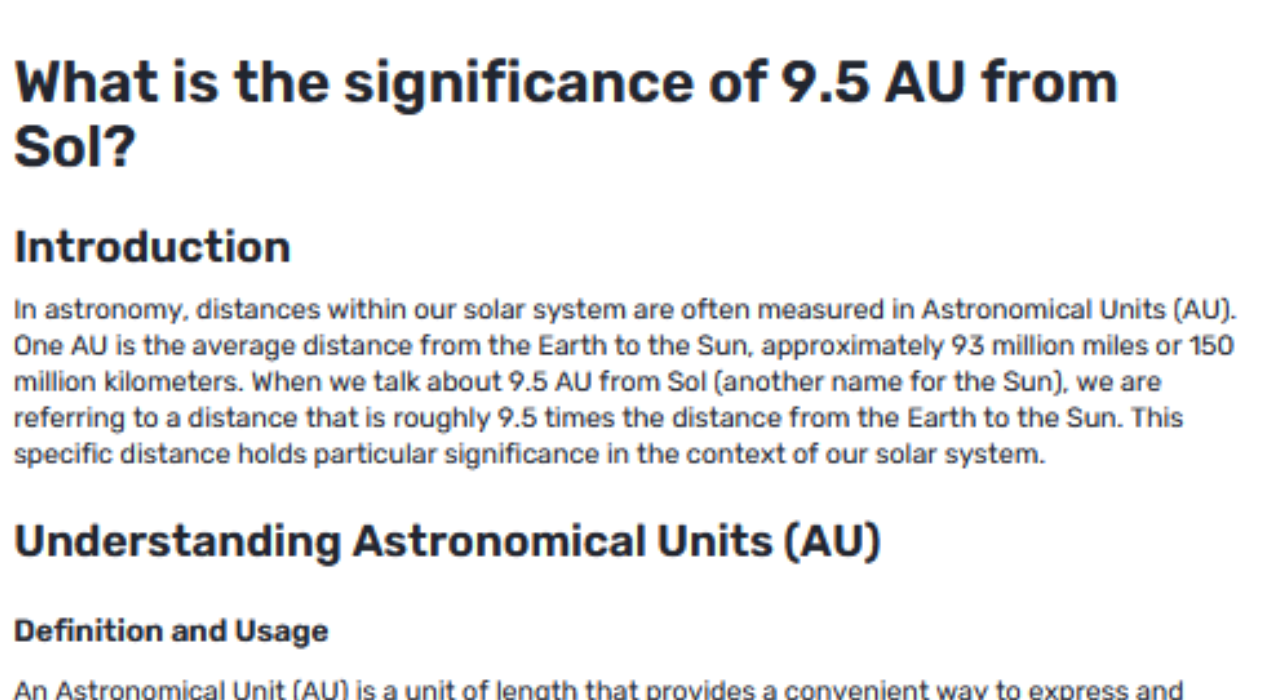Space science frequently includes estimating huge distances that can be trying to grasp. Distances inside our planetary group, like 9.5 Astronomical Unit (AU) from Sol (the Sun), are urgent for grasping the positions and developments of divine items. Exact estimations are crucial for different parts of cosmic examination, including planetary science, space missions, and the investigation of the planetary group’s construction.
Therefore, it becomes an important concept to understand the procedure followed by astronomers for measuring distances. In this article, we will investigate how stargazers measure distances like 9.5 au from sol and why these estimations are fundamental for propelling our insight into space.
Process Followed by Astronomers to Measure Distances
Estimating galactic distances includes various methods, each fit to various scales and kinds of estimations. For distances like 9.5 AU, cosmologists utilize a few techniques to accomplish accuracy.
Astronomical Unit (AU) as a Standard Estimation
A Astronomical Unit (AU) is a standard unit of distance used to depict distances inside our nearby planet group. One AU is characterized as the normal distance between the Earth and the Sun, roughly 149.6 million kilometers (93 million miles). This unit works on the statement of distances inside the planetary group, making it simpler to convey and comprehend.
Involving AU as a standard estimation assists astronomers with conveying distances in a more reasonable structure, decreasing the intricacy of managing very enormous or small numbers. For example, 9.5 AU addresses a distance that is 9.5 times the typical separation from the Earth to the Sun, which helps in figuring out the overall places of divine items.
Radar Going
Radar going is a method used to gauge the distance to local divine items by skipping radio waves off them and estimating the time it takes for the waves to return. This technique is especially compelling for estimating distances to planets inside our planetary group, like Mars and Venus.
A radar signal is sent from Earth toward the objective item. The sign bounces off the item and gets back to Earth. By working out the time it takes for the sign to return and knowing the speed of light, astronomers can decide the distance to the article.
Radar going gives profoundly exact distance estimations to objects inside the nearby planet group, permitting stargazers to decide their positions and circles with incredible accuracy. For distances like 9.5 AU, radar running aids in refining how we might interpret the spatial course of action of planets and other planetary group bodies.
Parallax Strategy
The parallax strategy includes estimating the evident change in the place of a heavenly item as seen from various vantage focuses. This shift, or parallax point, permits stargazers to compute the distance to the item utilizing geometry.
Perceptions of the item are produced using two distinct situations on The planet, isolated by a known distance. The clear change in the article’s position is estimated. Utilizing the realized detachment distance and the noticed parallax point, the distance to the item is determined.
The parallax strategy is basic for deciding the distances to local stars and items inside the nearby planet group. Despite the fact that parallax estimations are all the more usually utilized for stars past the planetary group, it can likewise assist with refining estimations for objects inside the nearby planet group, including those around 9.5 AU from the Sun.
Shuttle Perceptions
Rockets furnished with exact instruments can gauge distances to divine items by straightforwardly noticing their situations from space. This strategy gives important information, particularly for objects that are excessively far off or excessively faint for ground-based estimations.
Rocket outfitted with distance-estimating instruments, like imaging cameras or laser altimeters, notice the objective article. The rocket sends information back to Earth. Ground-based groups dissect the information to decide the distance to the item.
Steps for Using Gauth for Problem Solving
Here are the steps you can follow to use Gauth:
Step 1: Open Gauth
Start by opening the Gauth application on your cell phone or getting to it through their site on your PC. When you have the application open, ensure you are associated with the web, as Gauth needs an internet based association with capability. The point of interaction is intended to be natural..
Step 2: Enter Your Question
In the wake of opening the application, the subsequent Step is to enter the numerical problem you really want assistance with. You can either type the issue straightforwardly into the info field or utilize the application’s camera component to snap a picture of the issue.
Step 3: Get the Solution
When you have the solution, get some margin to completely survey it. Gauth gives clear clarifications that guide you through each step of the critical thinking process. Evaluating the solution is significant in light of the fact that it builds up how you might interpret the material.

Ending Thoughts
Estimating distances like 9.5 AU from Sol includes a mix of strategies, including the utilization of Galactic Units, radar going, parallax, and space apparatus perceptions. These techniques give fundamental information that helps different parts of stargazing and space science. Exact distance estimations are essential for figuring out the planetary group’s design, arranging space missions, and progressing logical exploration.

